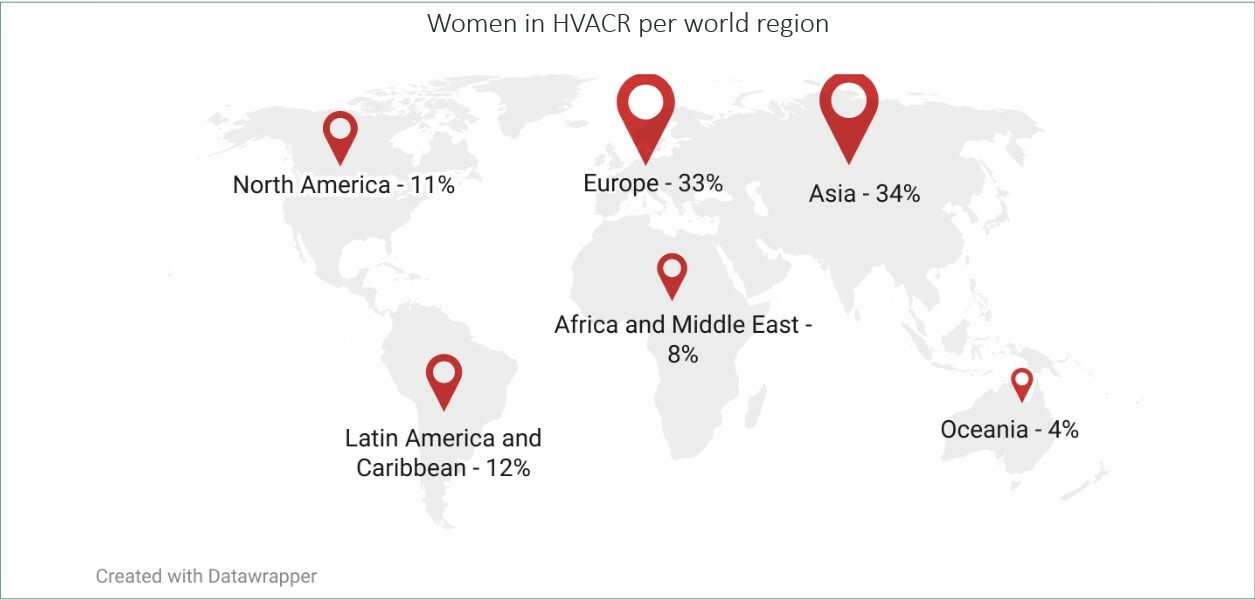The refrigeration sector celebrates International Women's Day and World Engineering Day
Engineers and technicians make up the bulk of the workforce in the refrigeration and heat pump sector, a growing sector in which all professions are accessible to women.
UNESCO proclaimed the 4th of March as World Engineering Day for Sustainable Development, to raise awareness of the contribution engineers can make to a sustainable future. Engineers and technicians in the refrigeration and heat pumps workforce play a key role in mitigating the impact of climate change. Although the sector is currently male dominated, all professions are accessible to women, offering the motivating prospect of a career involving key topics such as energy efficiency, technology selection or compliance with environmental regulations.
Engineering jobs in refrigeration and heat pumps
The IIR estimated that over 15 million people are employed in the refrigeration industry, which includes the cold chain for food and health products, air conditioning, cryogenics and heat pumps. 1 According to the IEA, 800,000 people are employed in the heat pump sector alone. 2
Engineers and technicians make up a great part of this workforce, through occupations related to the installation, maintenance and repair of refrigeration systems, along with their architecture and design. 3,4 In the USA, for instance, over 300,000 people work in engineering related to heating, ventilation, air conditioning and refrigeration (HVACR). 5,6
With such a sizable workforce, the profession’s capacity for growth is astonishing. In 2022, global employment growth in heat pumps was 27%, significantly outpacing the general growth rate of 2%.2, 7 The need for engineering and technical staff is steadily increasing due to the growing demand for cooling, fuelled by an increasing population and climate change.
Refrigeration engineers and technicians at the heart of climate change mitigation
The refrigeration sector is recognised within the United Nations as a development priority for its benefits to human life, and an environmental priority for its impact on climate change. The refrigeration sector impacts largely on energy consumption worldwide, due mainly to the great number of installed devices. With a substantial proportion of energy expended in this sector and growing awareness on climate change issues, engineers are needed to design energy-efficient refrigeration systems.
Heat pumps are crucial for climate change mitigation. The uptake of heat pumps for residential applications (e.g. air conditioning and heating), as well as for industrial applications, requires engineers to design the systems according to current standards and regulations.
Concerning the food cold chain, designing and installing food cooling systems presents many technical challenges, especially in hot climates where they are sorely needed to reduce food losses.
Find out more about designing cold rooms in hot climates
Promoting diversity and employment of younger professionals
Refrigeration engineering is a dynamic industry that offers excellent job prospects for young professionals. In the USA, for example, 20% of HVAC engineers are between 20 and 30 years old. 8 In terms of diversity, equity and inclusion (DEI), companies in the sector are implementing initiatives to promote a more inclusive workforce.9 For example, companies in France that employ 20 people or more are required to include 6% disabled people in their workforce.
The IIR has a working group dedicated to promoting careers in refrigeration to the younger generations, and particularly women.
Careers in Refrigeration “CaRe”
Sources
[1] IIR (2019) The Role of Refrigeration in the Global Economy (2019), 38th Note on Refrigeration Technologies. https://iifiir.org/en/fridoc/the-role-of-refrigeration-in-the-global-economy-2019-142028
[2] IEA (2023), World Energy Employment 2023, IEA, Paris https://www.iea.org/reports/world-energy-employment-2023
[3] IIR (2024) The HVACR workforce in the United States in 2022. https://iifiir.org/en/news/news-web-jan-2024-the-hvacr-workforce-in-the-united-states-in-2022
[4] IIR (2020) Employment in the refrigeration sector in France https://iifiir.org/en/news/l-emploi-dans-le-secteur-du-froid-en-france-in-french
[5] Bureau of Labor Statistics, U.S. Department of Labor, Occupational Outlook Handbook, Mechanical Engineers. https://www.bls.gov/ooh/architecture-and-engineering/mechanical-engineers.htm (visited February 29, 2024)
[6] Bureau of Labor Statistics, U.S. Department of Labor, Occupational Outlook Handbook, Stationary Engineers and Boiler Operators. https://www.bls.gov/ooh/production/stationary-engineers-and-boiler-operators.htm (visited February 29, 2024).
[7] International Labour Organization (ILO). https://www.ilo.org/global/about-the-ilo/newsroom/news/WCMS_865256/lang--en/index.htm
[8] HVAC Engineer Demographics and Statistics https://www.zippia.com/hvac-engineer-jobs/demographics/ (visited February 29, 2024)
[9] https://www.weforum.org/publications/global-gender-gap-report-2023/in-full/gender-gaps-in-the-workforce/

